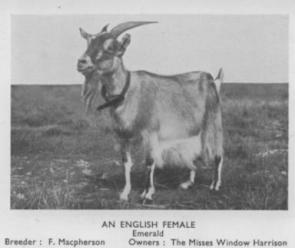Once the typical cottagers’ goat in the 19th century, the Old English became less common as incomes rose and fewer people needed a house goat. Goats were imported and it became fashionable to breed bigger, higher-yielding types. A Stud Goat Scheme, pioneered by an early British Goat Society (BGS) which made males of these ‘improved’ breeds available, hastened the demise of the native domestic goat. It’s possible that there are no non-feral goats in the country which have no Swiss or Nubian ancestry at all. Interest in the traditional goats was revived in the 1920s (see Emerald below) and again in the 1970s. In 2020 there were fewer than 50 registered Old English Goat keepers in the UK with just over 100 registered goats. Since recognition of the breed in late 2020, numbers of breeders and goats have slowly begun to climb. Whilst still an RBST RED list (critical) breed, it is hoped that an increased interest in the breed will aid this recent recovery. Re-domesticated wild/feral goats from particular populations are sometimes introduced as part of the breed. This replicates the old practice of “sending the nanny up the hill”, whereby a cottager – not wanting to keep & feed a billy year-round – would release their nanny up onto the unfenced hill/mountain land, to search out a suitable wild billy goat with which to mate. Knowing where the best food was, the nanny would return to the cottager, pregnant by the wild male.
